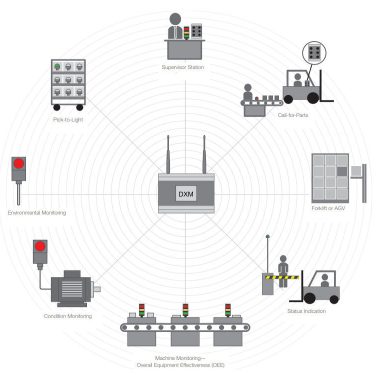

Wireless Sensing and Monitoring for Data
- Predictive Maintenance: Monitor critical machine components
- OEE / Productivity Monitoring: Gather production data remotely
- Call for Parts Solutions: Improve product flow to and from production areas
- Monitor Temperature & Vibration
- Monitor Temperature & Humidity
- Monitor Pressure, Current, Moisture
- Alarms: Send Email / Txt Alerts
- Cloud Data Storage
- Pre-Configured Solution Kits
What is Banner Wireless?
- Banner Wireless is used to send I/O data (discrete, analog, serial, Modbus, etc.) wirelessly between Nodes and Gateways
- Unlike Wi-Fi, Banner Wireless uses a dedicated binding address between Gateway and Nodes to establish communication
- The communication utilizes FHSS (Frequency Hopping Spread Spectrum) to minimize potential communication interference
- Only sends IO data, not specific information. Difficult to “hack”.
- Networks are available in 900 MHz or 2.4 GHz
Why use Banner Wireless?
Banner Wireless improves your ability to collect data from your operations
- You can create wireless networks without incurring the cost of wiring and conduit
- You can Retrofit older equipment so that it is Industrial Internet of Things (IIoT) capable
- You can access remote machines, tanks or silos. No need to climb or visit remote areas to gather data
- You can easily establish a predictive maintenance program to monitor the health of crucial machine components
- Older machines that were not intended for data collection can become part of the factory network
What type of Networks are available?
DX80 Networks, up to 47 Nodes
- Point to Point or Star Topology: Gateways communicate to Nodes and any connected Host System (PLC)
- Less complicated – Nodes talk only to the Gateway, the Gateway can be used as repeater
Multi-Hop Networks, Up to 50 Devices
- Utilize a Tree Topology: Master communicates to slaves
- Able to use repeaters
What is the difference between Gateways and Nodes?
Gateway
- Collects data from all nodes to a single point
- Outputs to Host System via Modbus RS485, Modbus TCP, & Ethernet IP
- Assigns network ID to nodes and monitors network connection of nodes
- Can link I/O between nodes to allow wireless control
- Many gateways include on-board I/O
Nodes
- Gather device data from discrete and/or analog inputs
- Nodes with 1-wire serial interface collect data from Banner wireless sensors
- Control local device via outputs
- Some Nodes have Sensors built in
What type of Nodes are available?
Node Configurations
- Node Power: Available in number of power configurations; Battery Powered by internal battery, DC Powered by an external source such as a power supply, AC Powered
- Node I/O: Available with different configurations of; Analog Inputs, Digital Inputs, Serial Inputs, Digital Outputs, Analog Outputs, Combinations of Analog and Digital
- Node Housings: Available in compact Q45 Sensor Housings, Performance Series Housings with or with out QD/Terminals, Board Level
- Sensors: Integrated or Remote depending on type and application
What type of Sensors are available?
Nodes
- Current, 20A and 150A
- Pressure, 0-50psi, 0-150psi, 0-500psi
- Temperature
- Vibration
- Humidity
- Moisture
